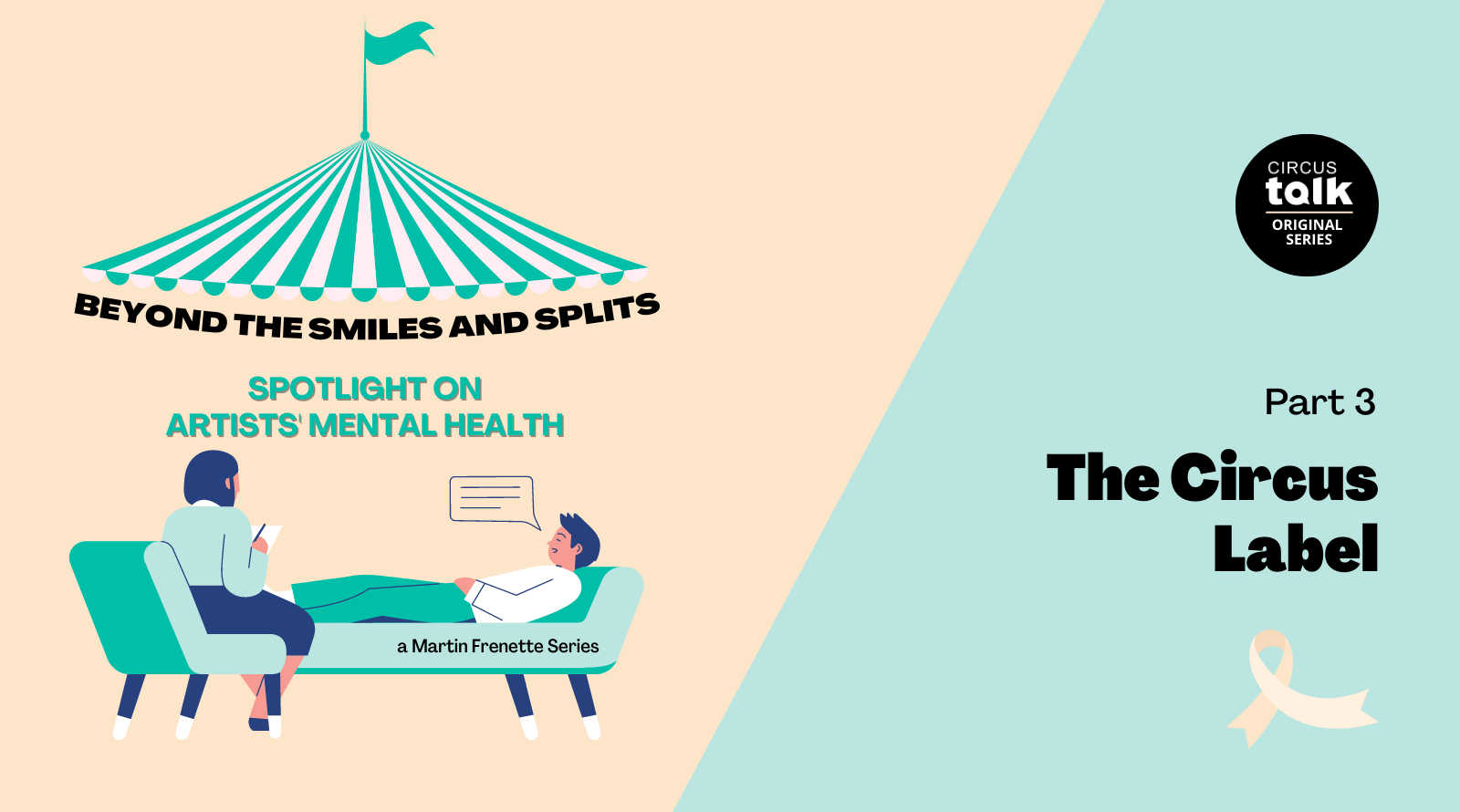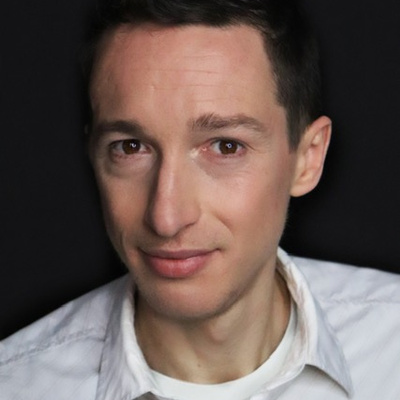Beyond Smiles and Splits – The Circus Label
We live in a time where labels and their necessity are questioned. Does a product need a known brand to really sell and what happens when said brand faces backlash or controversy? Why have skin color and DNA become a factor and an important discussion in the democratic act of voting? The list goes on and circus artists also have a label to deal with. Is getting booked on a big tour right after graduating circus school and performing 40 shows a month a requirement for being called a circus artist? Does this label bring prejudice to those wearing it? Take a closer look at the “circus label” with Beyond Smiles & Splits.
Looking deep into Grace’s green eyes, I can see something is bothering her. The young circus artist sitting across from me looks somewhat unbalanced as if she were sitting between two chairs. Barely a year out of circus school and, whilst her smile remains broad, that newcomer twinkle has seemingly faded. “I’m living out of a suitcase. I adore my castmates, absolutely love the show I’m on, and I’m miserable. Miserable. I’m not a gypsy. This was my dream and that’s what circus artists do: they hit the road. They’re always gone and they love it. Am I still a circus artist if I’d rather have a sedentary life and perform in shows near the people I love?” she asks.
Sentences like “That’s what circus artists do” and “That’s what you like” are thrown about by people within and outside the industry. Being a circus artist means fitting a certain mold, checking several boxes in the what’s-expected list, and agreeing to certain generalizations. “Circus artists are night owls, they all like to drink and party every night.” “Foot jugglers and wire walkers want to live on the road, resent staying still, and are clueless about finances.” “Porters eat a lot and tell their flyers to reduce their portions.” These statements, which apply to some but not all, are what come to mind to general audiences and those who follow acrobats’ social media.
In a somewhat similar way that some don’t want to be labeled a certain gender because they don’t recognize themselves in a particular one, some circus artists have grown reluctant to have this not-so-glittery label.
“The identity of ‘circus performer’ is a big part of me but it is not the first thing that I say to people these days,” explains James Kingsford-Smith.
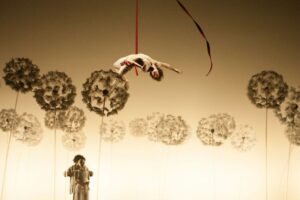
The Australian sees this profession as a lifestyle of uncertainty and a perpetual desire to take things to the next level. Perfectionism is something that is expected of circus artists, and no producer is interested in booking someone willing to give less than their best on stage. On one hand, there are those who have a compulsive need to repeat tricks and flips until they can’t get any lighter. Meanwhile, some choose to maintain the strength and agility that the show requires by rock climbing, weight lifting, swing dancing, or any other activity that brings them joy and the sentiment of being physically pushed. Does choosing to invest time and energy somewhere else than in their act and a rehearsal studio make them any less of a circus artist?
The old saying that “repetition leads to perfection” might as well be found embroidered on some circus tents or cleverly hidden in the Merriam-Webster Dictionary’s definition of “Circus.” There is no avoiding long hours of training to master the skills and consistency that employers and spectators expect of a performer. However, artists have an ever-expanding range of options to stay physically fit and mentally stable. If the most loving couple doesn’t feel like saying to their partner that they love them every other minute 20 or 30 years down the road, then even the most impassioned contortionist is entitled to a dance class on a random afternoon or picking apples on a day off. As former circus artist turned osteopath Faon Shane once told this journalist: “Being devoted to a discipline is essential to reach a certain level of performance, but engaging in other forms of physical activities that aren’t linked to a specific act is healthy, necessary even, and can have a drastic impact on someone’s physique, energy, and drive.”
Some believe that true circus artists run their act three or four times every day, that the “crème de la crème” trains every moment that they’re not on stage, and those alone are worthy of the “circus artist label.” They can claim to have a full-time job. There are artists who do need to train almost as much as they breathe and those who invest their energy elsewhere and still deliver solid performances are full-time artists too. Yes, it is a full-time job, but not in the 9-to-5 way our society defines it. One’s passions and investments can’t be defined nor valued by the hours spent pumping, stretching, balancing, and catching.
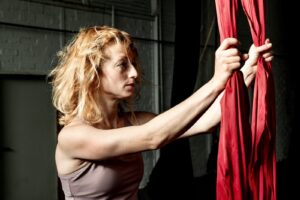
Aerial straps specialist and inspired creator Kaleen Mckeeman leans into the topic by going back to her roots: “We all have a human need to discover ourselves, and our education system has ways to help us. However, the spontaneity, grit and engagement in a circus environment always made me feel more at home. It helped me connect with myself and share it with the audience. These connections drew me into this world and kept me there at heart.”
10 years into her professional journey, Mckeeman wondered how she would stay involved with the art form and its community, how she would stay connected to herself if she weren’t on stage. The desire to have children, of investing as much in them as she had in the circus, made her walk off stage. Having a schedule that no longer revolved around bows and show calls meant re-thinking everything: sedentary vs. nomadic, focusing on her body with a very subjective component she wasn’t in control of, and being more aware of little beings’ emotions than she had ever been of those of an audience.
Looking back, the mother of two says that she never felt like she no longer was a circus artist: “I actually felt it more than I thought I would. I had plenty to do but nevertheless held on to the circus. I kept having ideas and creating images in my mind and found ways during my studies in the arts to reconsider its meaning. I found that I could still be a circus artist without being on stage.”
Both she and Kingsford-Smith agree that the discipline that artists learn to live by serves them when achieving other projects and maintaining a good performance level even when contracts aren’t piling up.
Artists learn how hard it is to do six, eight, ten shows a week. Learn how to maintain their body and mind to a certain level of performance and happiness. Some love every bit of it, love this strangely satisfying inability to lift their bag after a two-show day. That exhaustion is a big part of it to them, for those who not only plan their entire day around the time they’ll go on stage, but preserve the best of their energy for an audience.

If discipline is the glue that makes that circus label stick, then creativity is the font and the curves used to write on it. That’s where the two straps artists meet again. After years of paying their dues and doing all these doubles with Cirque du Soleil, Circa, The 7 Fingers, or Scotch & Soda, Mckeeman and Kingsford-Smith have found a new sense of fulfillment and development through research and creation. They aren’t hitting the stage as often as some of their former castmates, but the time and concentration each puts into creating new pieces are as important as any tumbler appearing in Mystère orHumans 2.0.
“I’m still surprised by how I made it to the ground from being an aerialist. Becoming a teacher has taught me a lot about the audience and becoming a mother has changed my voice as an artist, which is why I feature this side of myself in my performance research,” adds Mckeemann a few days before unveiling her first one-woman show in Berlin.
For Kingsford-Smith, creativity is what also allows circus artists to land on their feet and quickly bounce back when thrown a curve ball. Acrobats are used to a music cue going on at the wrong time, equipment being stuck at the border, or performing with a reduced cast due to food poisoning. “The show must go on”’ might be a cliché, but is nevertheless true. Even in non-performing environments, circus artists have a survival instinct, this ability to just find things that can make them more resourceful than the most studious academic of all.
That label and the presumptions that come with it are why some are laughed at when trying to enter a new field and “only have” 10 years of performing night after night, adapting to new environments, working with individuals that all speak different languages, and always making the customer (audience) happy. When the curtain falls on a show, when an artist packs their suitcase for the 87th time in a year, there are no diplomas being handed out to them, but their resume and life experience goes far beyond “performer on Show X.”
Regardless of how one feels about this label and how connected they are to the art form, it is up to each to shine some light on it or take it off. “I’m a circus artist” is not the first thing that needs to follow a handshake, but what it means can be the reason why they thrive and for how confident that handshake felt. There are as many ways to define what a circus artist is as there are disciplines and artists performing them. It is up to each to decide how and when to put the label forward.
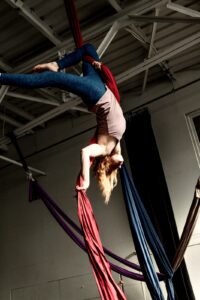
Images shared by Martin Frenette. Pictures of Kaleen taken by photographer Huma Rosentalski....
Do you have a story to share? Submit your news story, article or press release.

